What's New
Displaying results 3781 - 3790 of 4052
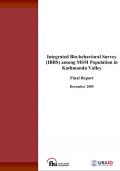
Resource | Publications,
The overall objective of the study is to determine the levels of HIV and STI prevalence and risk behavior among men who have sex with men (MSM) subpopulation in Kathmandu and their behavioral links with the general population or other groups with high-risk behaviors. The study will be useful to those, including FHI, seeking to design, monitor and evaluate the impact of their interventions and to advocate effective prevention and care interventions in MSM subpopulation.
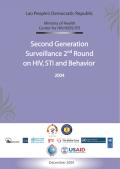
Resource | Publications,
This report is a summary of the first two rounds of national surveillance of behavioral and biological data among the populations believed to be at elevated risk of contracting and spreading HIV and STIs in Lao PDR. The first round was conducted in 2000/2001, and the second round in late 2004.
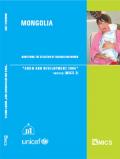
Resource | Publications,
The objective of the third survey is to make detailed estimates of the health, education and well being indicators and the exercise of their rights by the women and children of Mongolia. The results of the survey will be used in the preparation of a report which the Mongolian Government will present on progress of the implementation of the country commitment to the World Fit for Child Declaration. At the same time, the survey aims to assess and evaluate the monitoring indicators for progress in the implementation of the Millennium Development Goals.
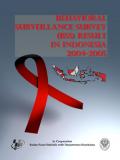
Resource | Publications,
The 2004/2005 BSS was essentially repetitions of the 2002/2003 surveys, with the survey locations and target groups largely being the same. However, the 2004/2005 BSS was expanded to cover additional target groups. In addition, a further location (Bandung municipality) was added. The target groups were expanded to include men who have sex with men and transsexuals in Jakarta, Surabaya and Bandung, and injecting drug users in Jakarta, Surabaya, Bandung and Medan. Meanwhile, the Army/Police Dept. target group was replaced by the Jayapura civil servant target group, while the sailor/fisherman target group in Karawang regency was replaced by the factory employee/operative target group. In the case of the youth target group, this was changed from youth between the ages of 15 and 24 (2002/2003 BSS in Merauke regency), to high school students in Surabaya municipality.
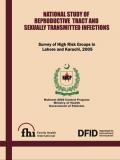
Resource | Publications,
Integrated Biologic (HIV/STI) and Behavioural Surveillance surveys were carried out from March to August 2004 in Lahore and Karachi in the following high-risk groups: injecting drug users, female sex workers, male sex workers, hijras (transgenders) and truckers. Sample sizes were 400 in each group at each site except for hijras, for whom the sample size was 200 at each site.
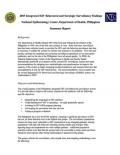
Resource | Publications,
In 2004, the National Epidemiology Center of the Department of Health and Family Health International undertook an evaluation of the current HIV surveillance system and made recommendations for adopting new methodologies and questionnaires to improve the capacity of the system to detect emerging localized epidemics and measure behaviors that put populations at risk for HIV transmission. The recommendations were accepted and the revised Integrated HIV Behavioral and Serologic Surveillance (IHBSS) system was implemented in 2005.
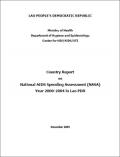
Resource | Publications,
The National AIDS Spending Assessment aims to assess the situation of the actual National expenditures on HIV/AIDS activities over the last five years (2000-2004) from different institutions. The total AIDS expenditure over the past five years is estimated at Lao Kip 148.62 billion (USD 14.85 million). The expenditure trend has shown the steadily increase steadily every year from 2.1 million in 2000 to 4.99 million in 2004. There were two sources of National AIDS Spending, from the government (in kind see table 2), and from external assistant. Remarkably, a large spending of AIDS came from external sources of 98.83 percent to 99.83 percent.
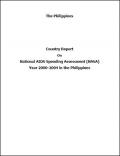
Resource | Publications,
The HIV/AIDS situation in the country can be described as hidden and growing. Based on the HIV/AIDS Registry of the National Epidemiology Center (NEC) of the Department of Health (DOH), the cumulative number of HIV/Ab seropositive cases has reached 2,373 since 1984. Epidemiologists and experts, however, estimate that the actual number of HIV cases is around 10,000. Despite the increasing number of cases, the prevalence rate remains consistently below one percent.
An examination of the country's total HIV/AIDS spending over the last five years (2000-20004) showed an erratic trend, peaking in 2001, and declining in the years that followed. Notably, a large share of total annual spending came from external sources (at least 75 percent).
The Philippines is committed to halting and reversing the spread of HIV/AIDS. Hence, mobilization of resources is critical in keeping the prevalence of HIV/AIDS low and the rate of transmission slow.

Resource | Fact Sheets,
Violence against women and girls is a global pandemic of alarming proportions, deeply rooted in gender inequality and discrimination. No woman or girl is entirely free of its risks or reach. It takes many forms and occurs in many places — domestic violence in the home; sexual abuse of girls in schools; sexual harassment at work and in public spaces; abuse during pregnancy; and rape in cities and in rural areas, in refugee camps and as a tactic of war. It includes harmful practices such as female genital mutilation/cutting, child and forced marriage, so-called 'honour' killings, acid attacks and dowry-related abuse; as well as newer forms, such as cyber-bullying and e-stalking via the internet and mobile phones. This fact sheet documents the scale of the pandemic.
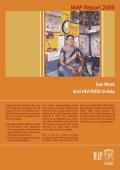
Resource | Publications,
People who buy and sell sex pose one of the high-risk behaviours for HIV exposure in Asia. It is therefore essential for HIV prevention interventions to take into account the nature of the Asian sex industry. The purpose of this booklet is twofold: 1. to summarize what researchers have learned about the epidemiology of HIV/AIDS within Asian commercial sex networks; and, 2. to discuss the programmatic implications of those findings.





